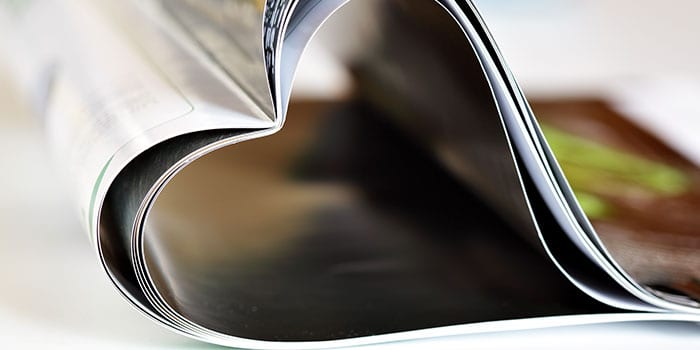Why I still love print
Print is rapidly falling out of favor, and it’s understandable, given the environmental sensitivities, the cost of paper, and the growing familiarity of digital media. But there are many reasons to keep using print communications for marketing. In fact, there are more reasons than ever.
The medium is the message.”
Most of the books I read today are on my Kindle or Kobo. I prefer the Kindle because I think Amazon has done a better job of managing the user experience, but that’s a topic for another discussion. Here’s what I noticed with both devices: the more I read digital content, the more everything feels the same. The books even open to the first page of content or the page you left off, leaving you without the repeat experience of the wonderful graphic design that helped propel you into buying in the first place. The only time you’re likely to even see the cover is when you first buy the book!
Everything is flat. Even. Textureless. I love to pick up one of those beautiful Easton Press “100 Greatest Books Ever Written” series so that I can run my fingers over the leather cover engraved with their intricate design and feel the embossing and the texture of that wonderful acid-free archival paper.
How I appreciate getting a letterpress-engraved invitation in the mail, where I can see the slight indentation of each and every letter in the classic paper texture.
Is it any wonder that we still love to hold a book? To flip real pages? Is it really surprising that we still love to experience the feeling of textured paper or the contrast of a high-gloss page framing a breathtaking National Geographic photograph? I think not.
The other day I got a direct response piece in the mail. It was a special invitation to view a new high-end real estate development in Vancouver. It was stunning. There is no way a digital communication piece, no matter how well designed, could have conveyed the message in the same way. There is just something incomparable about opening an envelope, pulling out a brochure and related materials, and marveling over the emotional response that can be achieved from spectacular photography and excellent graphic design.
The old New World of print design
Advertisers can take advantage of the power of print despite the cultural changes taking place. There’s a hunger out there for the tactile experiences that only print can give. But you need to be smart.
Good use of print involves a clear understanding of what print can do that digital media can’t. So don’t waste it.
Information should be kept to a minimum, so that your piece focuses on the emotional power of the message, not the inane details of product specifications or conditions.
Make your piece only as big as it needs to be, in order to demonstrate a sensitivity to environmental concerns. If you can create the impact with a smaller piece, whether fewer pages or smaller physical dimensions, don’t go larger just because you can. At the same time, there’s a reality that the size of the piece generally communicates the sense of importance. Larger brochures convey greater importance than smaller pieces can.
Make use of tactile features: paper textures, weight, embossing, letterpress, varnishes, foil. But for heaven’s sake, don’t apply too many of these elements at the same time! I’ve seen pathetic cases where people tried to use all of them at once, destroying any power the piece could have had.
Contrast is invaluable. The shiny, smooth finish of clay-coated paper and gloss varnish contrasts beautifully with onion-skin inserts or a rough textured cover. Gold foil contrasts in a powerful way with rough-hewn cover stock. The use of dull and high gloss spot varnishes can be spectacular.
For a high-end resort real estate property, those who expressed an interest with a deposit received a stunning coffee-table view book with a cover made of thinly-cut stone. With a piece like that to show friends and peers, the desire to complete the multi-million dollar purchase increases rather than struggling through the usual process of doubt and buyer’s remorse.
Best of all is the wonderful potential of negative space. When you’re holding the pages of a print piece, there’s magic in minimizing the amount of detail on each page, letting the parts of the message absorb into the mind one piece at a time, as the fingers turn the page for the next bit of information.
One of the most powerful aspects of print is the flexibility you have with the use of photographs. There’s something remarkable in how print can use images that cannot be duplicated in the digital realm. Photos can be placed where they intersect with the physical properties of the brochure; the folds and edges of each page. On one real estate brochure, for a resort property that featured a panoramic mountain view, we placed a photo in the top right corner of each page that worked like a flip book as your thumb flipped through the pages, giving you a 360-degree view of the peaks. Not everyone realized what it was, but most figured it out after a few pages, and found it both delightfully fresh and interactive.
So don’t write off printed brochures or mailers just yet. The medium has a lot left to give. You just have to be creative.



No Comments